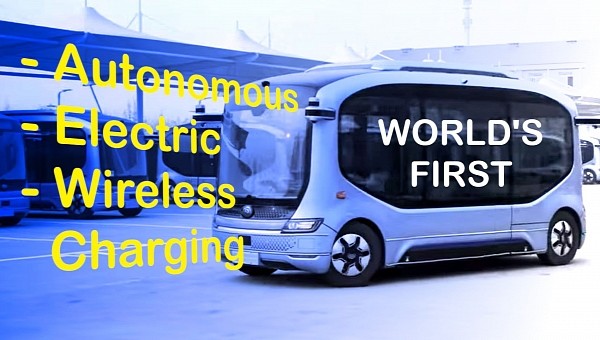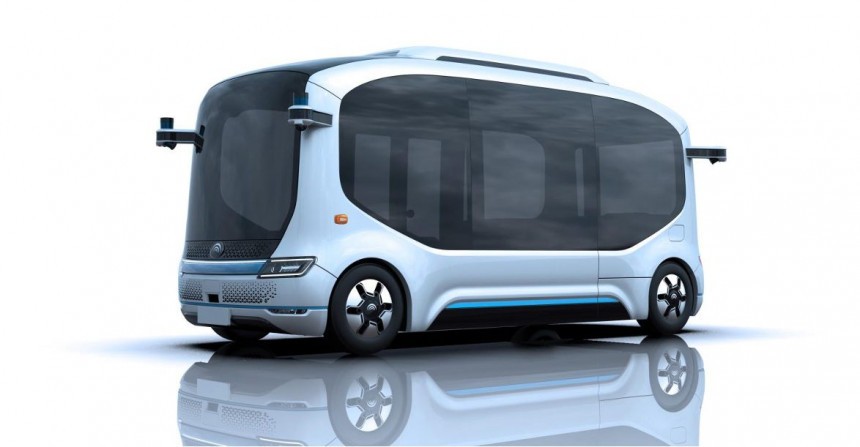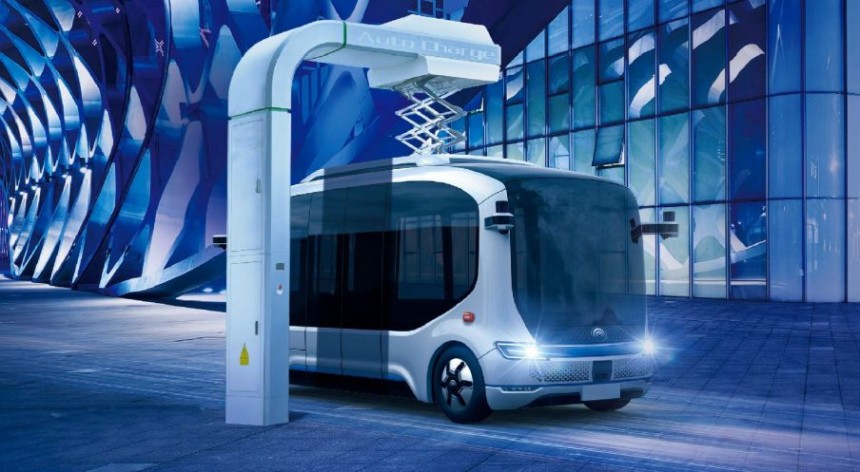Wireless charging is a little step for the industry but a giant leap for EV adoption. Until all the electric vehicles get to that point where they effortlessly charge without the need to plug in a cable, say hi to the little Chinese bus that recently became the first autonomous electric people carrier fitted with a wireless charger.
YuTong Bus is alleged “the number one bus brand in China,” while WiTricity likes to call itself “the leader in wireless EV charging.” It’s only normal that fitting a wireless charging system on this little e-bus to be marketed as “an industry first.”
This is kind of uncomfortable news for Zoox, and other American companies involved in developing and operating autonomous electric passenger vehicles. That’s because WiTricity is an American tech company, based in Watertown, Massachusetts.
Still, WiTricity chose to partner with a Chinese company to deploy its wireless charging system on an autonomous e-bus. What’s next, people, wireless charging a spy balloon?! I’m just joking, but such an idea is priceless for aviation...
Let’s get back to “the first-ever commercial application of wireless charging for an autonomous electric e-bus.” It is happening in Zhengzhou, China, where a fleet of micro-buses is fitted gradually with an 11-kW wireless charging system provided by WiTricity.
The little feller’s name is Xiaoyu 2.0, and you should know it has been awarded the design prize 2021 Red Dot Award in the category “Commercial vehicles.” That’s because the design of the bus has been inspired by spacecraft, precisely by space capsules. A hint to China’s space program ambitions, perhaps?
It can accommodate up to 10 passengers, which might seem unlikely because of its length of a mere 216 in. (5.5 m), which is less than a Ford F150 Lightning! But remember, this e-bus is designed from the ground up as an autonomous vehicle, so it’s got no steering wheel nor a driver’s place.
Under the floor sits a 70 kWh LFP battery, enough for about 93 miles (150 km) of range between charges. This is possible in part because its cruising speed is limited to a maximum of 25 mph (40 kph). That way, L4-level autonomous driving is considered perfectly safe in all weather conditions, thanks to laser radars, millimeter-wave radars, and cameras.
So, how does it charge? Like any other electric vehicle, it has a port for plugging in a fast-charging cable. The funny thing, WiTricity emphasizes that slips and falls because of the charging cords and cables are “the leading cause of workers’ compensation claims for commercial drivers.”
It's not the strongest argument for wireless charging, but maybe it could become one in a near-future world where public transport is fully electrified. It also was designed to fast-charge on special pantograph systems, using the mobile system placed on the roof.
Usually, these ports are placed in stations along the route and fast-charge the battery with enough energy in the minute needed for passengers to get out and onto the bus. The problem is the high intensity can affect a battery’s lifespan, especially for a low-capacity one like this e-bus.
And now it can be charged without the need for a cable. Which makes perfect sense when you realize it’s a driverless vehicle. For now, WiTricity's wireless system is placed in the depot. It is useful for night charging because the system’s relatively low power means several hours for a full charge.
But it also could be a solution for charging along the route, when a 50-kW system becomes available. Imagine that every station along the route has such a wireless integrated into the road. And every time the e-bus stops to collect passengers, its battery is charging a little bit, just enough to get to the next station.
WiTricity already conducts taxi trials, where wireless charging is used in queues to give the cars “power snacks” as they wait for their next trip. It’s simple and reliable, as the battery is not stressed out with high power currents. And it’s perfectly in line with the autonomous usage of the e-bus.
We have yet to see if a future Xiaoyu 3.0 or 4.0 claims the title for the first autonomous e-bus to wirelessly charge while driving. There are already several pilot projects, where vehicles can charge while in motion thanks to the wireless coils embedded in the road.
This solution also means that such a vehicle could use a much smaller battery, as there would be no more need to “bottle up” a large amount of energy. We’re very curious if the U.S. will have an edge on this, but at this point, it’s too soon to place the bets.
So, pretty soon, all the Xiaoyu self-driving mini-e-buses will be fitted with WiTricity’s wireless charging system, and they will be able to charge by themselves. Now, here me out: if such a people carrier can drive by itself and also charge by itself, how about using such a fleet 24 hours a day?
It's far less costly than having two or three drivers for each vehicle. And it’s convenient for a lot of people to have access to public transport even at night. As long as self-driving tech is used for such vehicles, which simply move passengers around, there’s a chance that the fine people from “Drivers-only Republic” won’t throw stones at wireless charging and autonomous driving.
This is kind of uncomfortable news for Zoox, and other American companies involved in developing and operating autonomous electric passenger vehicles. That’s because WiTricity is an American tech company, based in Watertown, Massachusetts.
Still, WiTricity chose to partner with a Chinese company to deploy its wireless charging system on an autonomous e-bus. What’s next, people, wireless charging a spy balloon?! I’m just joking, but such an idea is priceless for aviation...
Let’s get back to “the first-ever commercial application of wireless charging for an autonomous electric e-bus.” It is happening in Zhengzhou, China, where a fleet of micro-buses is fitted gradually with an 11-kW wireless charging system provided by WiTricity.
The little feller’s name is Xiaoyu 2.0, and you should know it has been awarded the design prize 2021 Red Dot Award in the category “Commercial vehicles.” That’s because the design of the bus has been inspired by spacecraft, precisely by space capsules. A hint to China’s space program ambitions, perhaps?
Under the floor sits a 70 kWh LFP battery, enough for about 93 miles (150 km) of range between charges. This is possible in part because its cruising speed is limited to a maximum of 25 mph (40 kph). That way, L4-level autonomous driving is considered perfectly safe in all weather conditions, thanks to laser radars, millimeter-wave radars, and cameras.
So, how does it charge? Like any other electric vehicle, it has a port for plugging in a fast-charging cable. The funny thing, WiTricity emphasizes that slips and falls because of the charging cords and cables are “the leading cause of workers’ compensation claims for commercial drivers.”
It's not the strongest argument for wireless charging, but maybe it could become one in a near-future world where public transport is fully electrified. It also was designed to fast-charge on special pantograph systems, using the mobile system placed on the roof.
And now it can be charged without the need for a cable. Which makes perfect sense when you realize it’s a driverless vehicle. For now, WiTricity's wireless system is placed in the depot. It is useful for night charging because the system’s relatively low power means several hours for a full charge.
But it also could be a solution for charging along the route, when a 50-kW system becomes available. Imagine that every station along the route has such a wireless integrated into the road. And every time the e-bus stops to collect passengers, its battery is charging a little bit, just enough to get to the next station.
WiTricity already conducts taxi trials, where wireless charging is used in queues to give the cars “power snacks” as they wait for their next trip. It’s simple and reliable, as the battery is not stressed out with high power currents. And it’s perfectly in line with the autonomous usage of the e-bus.
We have yet to see if a future Xiaoyu 3.0 or 4.0 claims the title for the first autonomous e-bus to wirelessly charge while driving. There are already several pilot projects, where vehicles can charge while in motion thanks to the wireless coils embedded in the road.
This solution also means that such a vehicle could use a much smaller battery, as there would be no more need to “bottle up” a large amount of energy. We’re very curious if the U.S. will have an edge on this, but at this point, it’s too soon to place the bets.
So, pretty soon, all the Xiaoyu self-driving mini-e-buses will be fitted with WiTricity’s wireless charging system, and they will be able to charge by themselves. Now, here me out: if such a people carrier can drive by itself and also charge by itself, how about using such a fleet 24 hours a day?
It's far less costly than having two or three drivers for each vehicle. And it’s convenient for a lot of people to have access to public transport even at night. As long as self-driving tech is used for such vehicles, which simply move passengers around, there’s a chance that the fine people from “Drivers-only Republic” won’t throw stones at wireless charging and autonomous driving.









